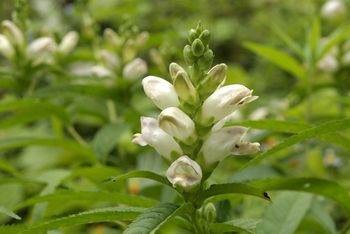Balmony
Other Names : Chelone glabra, Turtlehead, white turtlehead, turtlebloom, bitter herb, salt rheum weed, shellflower, snakehead, galane glabre, chelone, skjoldblomst, Kahle Schildblume, snauskjoldblom, sköldpaddsört.The plant is an herbaceous species native to North America. Its native range extends from Georgia to Newfoundland and Labrador and from Mississippi to Manitoba. Its natural habitat is wet areas, such as riparian forests and swamps. Its classification at the family level has in the past been controversial, but as a result of DNA sequence studies, it is now regarded as belonging to family Plantaginaceae (the plantain family)harvested when in flower and is dried for later use..
Special Precautions of Balmony
- There are no reports of toxicity, contraindications or adverse side effects of moderate doses of balmony.
- No information is available on how the herb will affect pregnant or breastfeeding women.
Health Benefits and Uses of Balmony
Balmony has a long history as a medicinal herb in North American folk medicine, but the herb’s alleged medicinal properties have not been backed up by scientific methods and its therapeutic applications are solely based upon traditional uses.
- Balmony is a very bitter herb with a tea-like flavour that acts mainly as a tonic for the liver and digestive system. Because the herb contains bitter substances it is regarded to helpful in stimulating appetite by increasing the secretion of digestive fluids and it is thought to be of values as a remedy for various liver ailments, and act as a general enhancer for the entire digestive system.
- The herb has been used traditionally to relieve nausea, vomiting, and colic (intestinal cramps), and as a remedy for indigestion (dyspepsia), general weakness, anorexia and to get rid of intestinal parasites (worms).
- The herb also has anti-depressant and laxative effects.
- A decoction of the whole herb is antibilious, aperient, appetizer, cathartic, cholagogue, detergent, tonic, vermifuge.
- as a natural treatment for gallstones, gallbladder inflammation, and jaundice.
- It is also regarded to have a laxative effect.
- The herb is also touted to have anti-depressant properties.
- It is also used to relieve nausea and vomiting, intestinal colic and to expel worms.
- Externally, it is applied as a soothing ointment to piles, inflamed tumours, irritable ulcers, inflamed breasts etc. In the past, the Native Americans were known to have used balmony for blood purification purposes and as a treatment for atopic eczema (atopic dermatitis) and chronic rheumatic conditions.
References
- Bown. D. Encyclopaedia of Herbs and their Uses. Dorling Kindersley, London. 1995 ISBN 0-7513-020-31
- Stuart. M. (Editor) The Encyclopedia of Herbs and Herbalism Orbis Publishing. London. 1979 ISBN 0-85613-067-2
- Foster, Steven and James A. Duke: A Field Guide to Medicinal Plants, Eastern, and Central North America. New York, Houghton Mifflin Company 1990.
